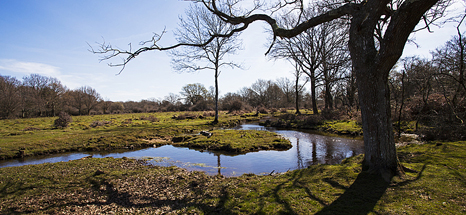 This piece was originally delivered as a speech by Forestry Commission Deputy Surveyor Bruce Rothnie at the September 2016 Verderers’ Court.
This piece was originally delivered as a speech by Forestry Commission Deputy Surveyor Bruce Rothnie at the September 2016 Verderers’ Court.
Fish are a vital part of the ecology of the Forest and we all want to know that their surroundings are in a condition where they can thrive. In many places across the Forest the streams have the natural diversity of conditions that are good for fish – gravel riffles, pools, and vegetation in the water and along the bank. The stream life is in harmony with the natural processes of the site and robust to weather variations.
Unfortunately in some places man’s intervention by straightening and deepening the streams has upset these natural processes and reduced the natural diversity upon which fish and other stream life depend. The straighter channels increase water flow which strips them of gravels, vegetation and the natural variation of water depth that is so vital for all stages of fish development.
We all know that ponies grazing on the Forest need the freedom to roam in order to thrive. They can find shelter from hot or stormy weather; they can find water in ponds and streams; and they can exploit the range of vegetation at different places and at different times of year. Imagine if they were to be constrained to areas without this variation – their condition would quickly deteriorate.
(Trout spawning at Harvestslade, just months after restoration)
The same is true for fish and we have an opportunity through our stream restorations to re-establish the diversity. By restoring meandering streams we provide the physical conditions from which the natural processes can take over and the stream life can return at nature’s pace. These changes do not occur overnight and we have seen at sites restored in the past that benefits can show quickly but may take years to establish fully.
Of course we are concerned about disturbing the existing fish populations during work. That is why we undertake fish surveys before work and then capture and relocate them downstream just prior to work starting – these techniques are widely used across the country and allow us to minimise the impacts on the existing population during work.
After the work we are carrying out further surveys of fish and invertebrates at sample locations to see how quickly the stream life returns. I was talking with one of the people doing this monitoring work the other day and I was struck by his enthusiasm about the increasing numbers of fish and invertebrates he had been observing over successive visits – its early days but very encouraging.
Concern has also been raised about higher water temperatures if scrub adjacent to the streams is removed and their shading effects lost. Often this scrub has established on the drier spoil banks created when streams were dredged. Removing this scrub allows us to flatten the spoil banks and permit the stream to flood out naturally during high flows onto the adjacent floodplain – a key part of restoring natural processes. This is important “surgery” before healing can take place.
Water temperatures will vary and it is this variation in different parts of the stream and at different times of the year that is important for the survival of fish at all of their stages of development. The vital factor is that fish have opportunity to utilise the natural temperature variation created by pools and riffles and the vegetation in the stream. So by restoring this physical diversity we also restore the natural temperature variations that we also seek.
All restoration schemes are planned and executed to minimise the impacts on wildlife. The measure of success of these schemes will come with evidence of their condition over time once nature has responded to the physical changes. Anyone left in doubt that these transformations are beneficial should visit some of the earliest sites on the Forest restored in the early 2000s – their condition is impressive and certainly more in character with the Forest we all know and love.